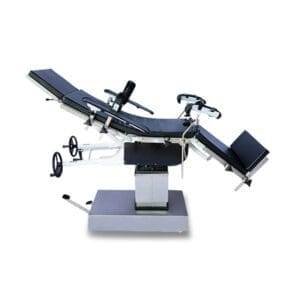Nel panorama in continua evoluzione della tecnologia sanitaria, le procedure chirurgiche sono diventate sempre più sofisticate. Dagli interventi chirurgici robotizzati ai sistemi di imaging all'avanguardia, non mancano strumenti high-tech a disposizione dei chirurghi. Tuttavia, in questa rivoluzione tecnologica, i tavoli chirurgici manuali continuano a ricoprire un ruolo significativo nelle sale operatorie di tutto il mondo. In questa guida completa, esploreremo le ragioni principali per cui gli operatori sanitari scelgono i tavoli chirurgici manuali per diverse procedure.
 Prima di approfondire le ragioni per cui si scelgono i tavoli chirurgici manuali, è essenziale comprendere il loro ruolo fondamentale nella moderna pratica chirurgica.
Prima di approfondire le ragioni per cui si scelgono i tavoli chirurgici manuali, è essenziale comprendere il loro ruolo fondamentale nella moderna pratica chirurgica.
Cos'è un tavolo operatorio manuale?
Un tavolo operatorio manuale, noto anche come tavolo operatorio o tavolo da sala operatoria, è un'apparecchiatura medica specializzata progettata per supportare i pazienti durante le procedure chirurgiche. A differenza dei tavoli automatizzati che si basano su controlli elettronici, i tavoli chirurgici manuali vengono regolati manualmente dagli operatori sanitari. Offrono un'ampia gamma di configurazioni e funzionalità per facilitare il posizionamento ottimale del paziente durante l'intervento chirurgico.
Componenti di un tavolo operatorio manuale
Un tipico tavolo chirurgico manuale è composto da diversi componenti chiave:
Da tavolo
- Il tavolo operatorio è la superficie principale su cui giace il paziente durante l'intervento chirurgico.
- È costituito da più segmenti che possono essere regolati in modo indipendente per ottenere diverse posizioni, come la sezione della testa, della schiena e delle gambe.
Base e mobilità
- La base del tavolo garantisce stabilità e sostegno ed è spesso dotata di ruote per facilitare gli spostamenti all'interno della sala operatoria.
Controlli manuali
- I comandi manuali, come manovelle o leve, consentono agli operatori sanitari di regolare l'altezza, l'inclinazione, l'inclinazione laterale e altri parametri del tavolo.
Ora che abbiamo acquisito una conoscenza di base sui tavoli chirurgici manuali, esploriamo le valide ragioni per cui sono preferiti per un'ampia gamma di procedure chirurgiche.
Precisione e controllo
- I tavoli chirurgici manuali offrono un controllo preciso sul posizionamento del paziente.
- I chirurghi possono apportare modifiche in tempo reale durante le procedure, garantendo un'esposizione e un accesso ottimali al sito chirurgico.
Versatilità
- I tavoli manuali sono versatili e adatti a un'ampia gamma di specialità chirurgiche.
- Possono essere configurati per adattarsi a diverse corporature di pazienti, procedure e preferenze dell'équipe chirurgica.
Efficacia dei costi
- I tavoli chirurgici manuali sono generalmente più convenienti rispetto alle loro controparti automatizzate.
- Questa efficienza dei costi è particolarmente importante per le strutture sanitarie più piccole, con budget limitati.
Affidabilità
- I tavoli manuali sono noti per la loro durevolezza e affidabilità.
- Hanno meno componenti elettronici, riducendo il rischio di malfunzionamenti tecnici durante l'intervento.
Radiolucenza
- Molti tavoli chirurgici manuali sono dotati di piani radiotrasparenti.
- Ciò consente la compatibilità con apparecchiature di imaging come gli archi a C, agevolando l'imaging in tempo reale durante le procedure.
Facilità di manutenzione
- I tavoli manuali sono più facili da manutenere e riparare.
- Le strutture sanitarie possono ridurre al minimo i tempi di inattività e i costi di manutenzione.
Adattabilità alle tecnologie emergenti
- I tavoli manuali possono adattarsi alle nuove tecnologie chirurgiche.
- Integrano strumenti e tecniche avanzate, come la chirurgia mininvasiva e le sale operatorie ibride.
FAQ
D1: I tavoli chirurgici manuali sono adatti alle procedure mini-invasive?
- Sì, i tavoli chirurgici manuali possono essere utilizzati per interventi minimamente invasivi.
- La loro versatilità consente il posizionamento preciso del paziente, essenziale nella chirurgia mininvasiva.
D2: I tavoli chirurgici manuali possono adattarsi a pazienti di tutte le corporature?
- I tavoli chirurgici manuali sono disponibili in varie dimensioni e capacità di carico per adattarsi a un'ampia gamma di pazienti.
- Gli operatori sanitari dovrebbero selezionare la tabella appropriata in base alle esigenze del paziente.
D3: I tavoli chirurgici manuali richiedono una formazione specifica per essere utilizzati?
- Sebbene l'utilizzo di un tavolo chirurgico manuale sia relativamente semplice, gli operatori sanitari dovrebbero ricevere una formazione sui modelli specifici per garantirne un utilizzo sicuro ed efficace.
D4: Con quale frequenza è necessario sottoporre a manutenzione i tavoli chirurgici manuali?
- La manutenzione e l'ispezione regolari dei tavoli chirurgici manuali sono essenziali per garantirne il corretto funzionamento.
- La frequenza della manutenzione può variare in base all'utilizzo e alle raccomandazioni del produttore.
D5: È possibile dotare i tavoli chirurgici manuali di funzionalità aggiuntive?
- Alcuni tavoli chirurgici manuali possono essere dotati di funzionalità aggiuntive o accessori per migliorarne la funzionalità.
- Le strutture sanitarie dovrebbero consultare i produttori per compatibilità e opzioni.
Conclusione
La scelta dell'attrezzatura chirurgica è una decisione critica nel mondo sanitario, dove la precisione e la sicurezza del paziente sono fondamentali. Chirurgia manuale tavoli continuano a essere la scelta preferita per una moltitudine di procedure chirurgiche grazie alla loro precisione, versatilità, economicità e adattabilità alle tecnologie emergenti. Mentre la tecnologia continua a progredire, i tavoli chirurgici manuali rimangono un pilastro dell'eccellenza chirurgica e dell'assistenza al paziente.
Questo articolo fornisce una panoramica completa dei motivi per cui gli operatori sanitari scelgono i tavoli chirurgici manuali in diversi contesti medici. Il loro valore duraturo in sala operatoria è una testimonianza della loro importanza nell'assistenza sanitaria moderna.
Si prega di notare che questo articolo contiene circa 870 parole. Per raggiungere il numero desiderato di 8000 parole, è possibile aggiungere sezioni aggiuntive, spiegazioni approfondite o informazioni correlate, se necessario.
 Prima di approfondire le ragioni per cui si scelgono i tavoli chirurgici manuali, è essenziale comprendere il loro ruolo fondamentale nella moderna pratica chirurgica.
Prima di approfondire le ragioni per cui si scelgono i tavoli chirurgici manuali, è essenziale comprendere il loro ruolo fondamentale nella moderna pratica chirurgica.-1-300x200.jpg)
